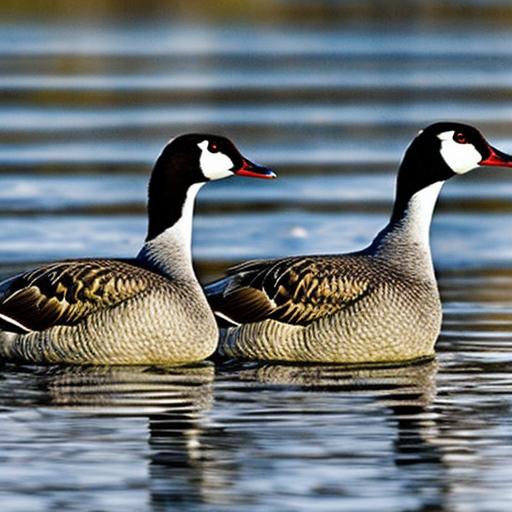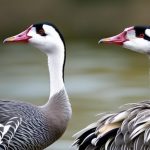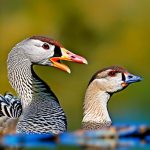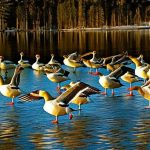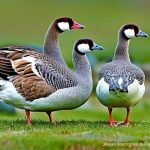Canadian geese, also known as Canada geese, are a familiar sight in North America. These large waterfowl are known for their distinctive honking call and V-shaped flight formations. Growing up in a small town in Canada, I have always had a close encounter with Canadian geese. I remember one particular incident when I was walking by a pond and suddenly found myself surrounded by a group of geese. It was both intimidating and fascinating to be in such close proximity to these majestic birds.
Key Takeaways
- Canadian geese are a common sight in North America and are known for their distinctive honking calls and V-shaped flying formations.
- Keeping Canadian geese is important for maintaining a healthy ecosystem, as they play a crucial role in seed dispersal and nutrient cycling.
- Canadian geese require access to open water, grassy areas for grazing, and safe nesting sites in order to thrive.
- Understanding the migratory patterns of Canadian geese is important for protecting their populations and ensuring their continued survival.
- Canadian geese provide a range of benefits to the ecosystem, including improving water quality, controlling vegetation growth, and providing food for predators.
The Importance of Keeping Canadian Geese
Canadian geese play a crucial role in the ecosystem. They contribute to the balance of nature by dispersing seeds through their droppings, which helps in the growth of vegetation. Additionally, they act as indicators of the health of wetland ecosystems. If the population of Canadian geese declines, it could be a sign of environmental degradation.
Furthermore, Canadian geese have cultural and historical significance. They have been an important part of indigenous cultures for centuries, symbolizing loyalty, bravery, and family unity. In addition, they have become a symbol of Canada itself, representing the country’s natural beauty and wildlife.
Habitat and Feeding Requirements of Canadian Geese
Canadian geese prefer habitats near water bodies such as lakes, ponds, and rivers. They are commonly found in wetlands, marshes, and coastal areas. These habitats provide them with ample food sources and protection from predators.
In terms of feeding habits, Canadian geese are primarily herbivores. They feed on grasses, sedges, aquatic plants, and grains. They are also known to graze on agricultural fields during migration periods when their natural food sources may be scarce.
Understanding the Migratory Patterns of Canadian Geese
Canadian geese are known for their annual migration patterns. They breed in the northern parts of North America during the summer and then migrate south for the winter. The migration routes can span thousands of miles, with some geese traveling as far as Mexico or even further south.
The migration of Canadian geese is influenced by several factors, including the availability of food and suitable breeding grounds. They also rely on favorable weather conditions, such as wind patterns and temperature, to aid in their long-distance flights.
The Benefits of Canadian Geese to the Ecosystem
Canadian geese play a vital role in maintaining the balance of ecosystems. As mentioned earlier, they disperse seeds through their droppings, which helps in the growth of vegetation. This, in turn, provides food and habitat for other species.
Additionally, Canadian geese contribute to the nutrient cycling process. Their droppings contain high levels of nitrogen, which enriches the soil and promotes plant growth. This benefits not only the vegetation but also the organisms that rely on it for food and shelter.
The Threats Facing Canadian Geese and How to Mitigate Them
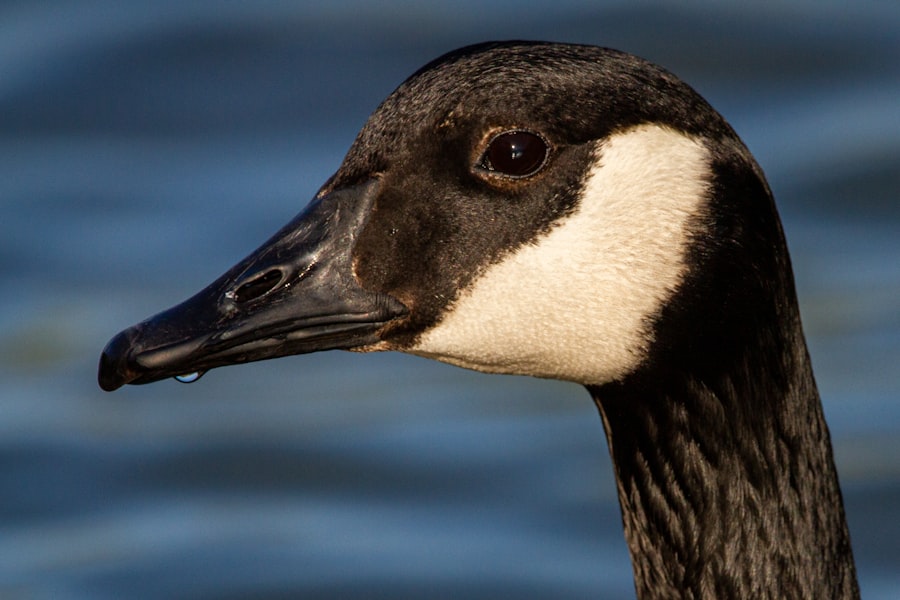
Despite their importance in the ecosystem, Canadian geese face several threats that can impact their population. Habitat loss is one of the major threats they face due to urbanization and agricultural expansion. Wetlands, which are crucial habitats for Canadian geese, are being drained or converted for other purposes.
Another threat is hunting. While regulated hunting can be sustainable and help manage populations, illegal hunting and poaching pose a significant risk to Canadian geese. This can lead to a decline in their numbers and disrupt their natural migration patterns.
To mitigate these threats, conservation efforts are essential. Protecting and restoring wetland habitats is crucial for the survival of Canadian geese. Additionally, implementing hunting regulations and enforcing them can help maintain sustainable populations.
The Role of Conservation Organizations in Protecting Canadian Geese
Conservation organizations play a vital role in protecting Canadian geese and their habitats. These organizations work towards preserving wetlands, advocating for hunting regulations, and conducting research to better understand the needs and behaviors of Canadian geese.
One such organization is Ducks Unlimited, which focuses on conserving wetlands and waterfowl habitats. They work with landowners, government agencies, and other stakeholders to protect and restore wetlands across North America. Their efforts have helped in the conservation of Canadian geese and other waterfowl species.
Tips for Attracting Canadian Geese to Your Property
If you are interested in attracting Canadian geese to your property, there are a few things you can do. Providing a suitable habitat is crucial, so having a pond or water source nearby is essential. Planting native vegetation around the water source can also attract Canadian geese as they provide food and shelter.
Additionally, providing food sources such as grains or grass can help attract Canadian geese. However, it is important to note that feeding wildlife should be done responsibly and in moderation to avoid dependency or health issues.
The Dos and Don’ts of Interacting with Canadian Geese
Interacting with Canadian geese can be a rewarding experience, but it is important to do so safely and respectfully. Here are some dos and don’ts when encountering Canadian geese:
Dos:
– Observe from a distance: It is best to admire Canadian geese from a safe distance to avoid disturbing them or their habitat.
– Respect their space: Do not approach or chase Canadian geese, especially during breeding season when they may become aggressive.
– Dispose of trash properly: Litter can harm wildlife, including Canadian geese. Dispose of trash in designated bins to prevent accidental ingestion or entanglement.
Don’ts:
– Feed them human food: Feeding Canadian geese human food can disrupt their natural diet and lead to health issues.
– Approach nesting sites: Nesting sites should be respected and left undisturbed to ensure the safety and well-being of the geese and their offspring.
– Harass or harm them: It is illegal and unethical to harass or harm Canadian geese. They are protected under various wildlife conservation laws.
The Future of Canadian Geese and How We Can Help
Canadian geese are an integral part of North America’s ecosystems and cultural heritage. Their presence signifies the health of wetland habitats and their migration patterns inspire awe and wonder. However, they face threats such as habitat loss and hunting, which can impact their populations.
To ensure the future of Canadian geese, it is crucial to support conservation efforts and protect their habitats. This can be done through supporting organizations like Ducks Unlimited, advocating for wetland conservation, and promoting responsible interactions with wildlife.
By taking these actions, we can help preserve the beauty and significance of Canadian geese for future generations to enjoy.
If you’re interested in learning more about keeping Canadian geese, you might also find this article on poultrywizard.com helpful. It discusses the importance of providing a suitable coop for chickens and provides insights on how big a coop needs to be for a chicken. Understanding the space requirements for chickens can also be beneficial when considering the needs of other poultry, such as guinea fowl. To read more about keeping guinea fowl with chickens, check out this informative article on poultrywizard.com. Additionally, if you’re specifically looking for information on chicken coops in Grand Island, NE, this article on poultrywizard.com provides valuable insights and tips.
FAQs
What are Canadian geese?
Canadian geese, also known as Canada geese, are a species of waterfowl native to North America. They are known for their distinctive black heads and necks, white chinstrap markings, and brownish-gray bodies.
Why is it important to keep Canadian geese?
Canadian geese play an important role in the ecosystem as seed dispersers and nutrient recyclers. They also provide recreational opportunities for birdwatchers and hunters. Additionally, they are a symbol of Canadian identity and culture.
What are some ways to keep Canadian geese?
Some ways to keep Canadian geese include habitat management, deterrents such as noise makers or visual barriers, and population control measures such as egg addling or relocation.
Why do Canadian geese sometimes become a nuisance?
Canadian geese can become a nuisance when they overpopulate an area, causing damage to crops, lawns, and golf courses. They can also pose a health risk due to their droppings, which can contain harmful bacteria.
Is it legal to harm Canadian geese?
Canadian geese are protected under the Migratory Bird Treaty Act, which makes it illegal to harm or kill them without a permit. However, there are some exceptions for population control measures that are carried out by trained professionals.
Meet Walter, the feathered-friend fanatic of Florida! Nestled in the sunshine state, Walter struts through life with his feathered companions, clucking his way to happiness. With a coop that’s fancier than a five-star hotel, he’s the Don Juan of the chicken world. When he’s not teaching his hens to do the cha-cha, you’ll find him in a heated debate with his prized rooster, Sir Clucks-a-Lot. Walter’s poultry passion is no yolk; he’s the sunny-side-up guy you never knew you needed in your flock of friends!

